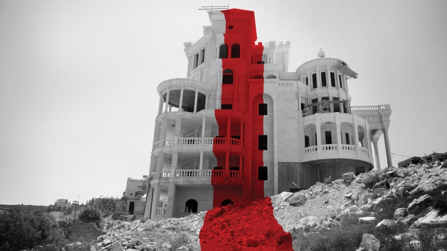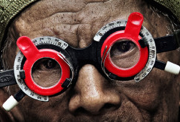Constructions of Truth – Forensic Architecture as a Fact Finding Tool in the Context of Human Rights Violations
by Nicola Popovic and Fiana Gantheret
Through designing public and private space, architecture has always been at the crossroads of aesthetics and function. The design of houses, public areas and cities depends maybe more than any other art form on the purpose of its use. Architectural products are an integral part of the life and movement of people. Their given social functions influence their construction. Therefore, typology of architecture, as well as the function and purpose of buildings and public or private spaces, can be indicators of politically-driven actions and initiatives at a given time. Human life and movement have been influenced by the planification and the development of buildings and landscapes. Architecture has grown into a potential mechanism of control of individuals and groups in modern times. Building walls or bridges, the restriction and control of freedom of movement through the design of correction facilities or housing demolition in armed conflicts, are potential infringements on human rights.
Forensis | The width of the line crossing the “Red Castle” in Battir | Photo: DAAR / Amina Bech
The analysis of the traces of human rights violations in buildings or other physical structures is the subject of Forensic Architecture, a research project funded by the European Research Council and hosted by the Centre for Research Architecture at Goldsmiths, University of London. Forensic Architecture assembles a team of architects, artists, activists and theorists and aims at gathering and presenting evidence in legal contexts and forums, and more specifically in the context of human rights and international criminal legal investigations.
Having identified the modern use of forensics as an instrument of the law and as a political practice being at the core of how states govern their subjects, the research project aims at undertaking a critical examination of the status of forensics and at reorienting the original acception of forensis in order to make it “a field of action in which individuals and organisations detect and confront state violations”. This is the vocation of the exhibition Forensis curated by Anselm Franke and Eyal Weizman that took place from March to May 2014 in Berlin, and of the book Forensis: the Architecture of Public Truth, co-published by Forensic Architecture. They present the work of the project team, as well as associates and guests, introduce to investigations led and the technologies used to analyse material objects, and explain how these technologies are mobilized in order to produce a new kind of evidence in international tribunals and in the struggle for justice in general.
The exhibition Forensis examined the traces of human rights violations on buildings and landscapes through carefully designed audio visual features. It focused on how evidence of grave human rights violations is gathered and contributes to cases at international criminal tribunals and other legal mechanisms. It showed the use of buildings during the armed conflict in the Former Yugoslavia, the environmental evidence of genocidal acts against the indigenous population in Guatemala, as well as the impact on the Cambodian landscape of bombs, mines and floods.
During his presentation at the Haus der Kulturen der Welt on April 27th 2014, Eyal Weizmann explained how “space is a testimony of multifactor impact”. The Israeli architect, intellectual, and professor of forensic architecture is one of the scientists on the project. He presented his research at the crossroads of international human rights law, architecture and engineering. Eyal Weizmann explains on the project website:
Forensic architecture typically refers to the practice of building-surveyors who assess building damage and structural integrity in legal contexts, often providing expert testimony in court. However, extracted from the specialized context of property and insurance disputes, the term could designate a general strategy for architectural research and enquiry, expanding the scope of what architecture can achieve in the world today.
Eyal Weizmann outlined during the exhibition the various dimensions of the impact conflict, violence and aggression have on objects, as these can be read on walls and buildings as well as on the environment and the elements, including water.
As developed in the Introduction to the book Forensis : the Architecture of Public Truth, the research project explores the notion of aesthetics, explaining that architecture “is aestheticized to its environment”, in that “matter can detect, register, and respond (…) to influences in its environment and to remote presence”. The work of forensic architects, then, is to read the registered impacts on the material objects, with lenses that are slightly different than the ones belonging to building surveyors. It is a “building surveyor of a new kind” who investigates the “material geology of contemporary conflict”.*
International crimes such as war crimes as defined in the Statutes of the International Criminal Tribunal for the former Yugoslavia and the International Criminal Court include extensive destruction of property, wanton destruction of cities, towns or villages, and intentional destruction of buildings dedicated to charity, religion, art and education, when committed without military necessity. Through these structural damages inflicted on homes and the environment, people are affected in multiple ways by armed violence and aggression. Forensic Architecture highlights the importance of a spatial transformative analysis. As every contact leaves a trace and any matter registers touch, the environment, constructions and physical presence or absence of objects can serve as evidence registering human behavior and action.
The research project also highlights the unequal power relationship between the state and its citizens. It describes how digital data of the impact on the environment is often withheld from the wider public or only known to the people immediately affected. This lack of data and analysis contributes to an incomplete establishment of the collective truth. Objectively verifiable changes in objects, environment or landscapes can therefore assist in exploring an additional dimension to the truth that may be displayed in the public discourse and in the prosecution of human rights violation.
Yet, the turn to exhumations does not produce a scenario in which the solid object provides a stable and fixed alternative to human uncertainties and ambiguities. On the contrary, the aesthetic, political, and ethical complications that emerge with this turn establish the dead body not as an alternative to testimonial practices, but rather their continuation.**
* Forensis: The Architecture of Public Truth, pp. 14-15.
** Forensis: The Architecture of Public Truth, p. 24.





je connais le travail de Eyal Weizmann, architecte , tres interressantbien sur que les pays en guerre font une architecture defensive et offensiveplus interressante est ce qu’il dit de la vitesse et de la lenteur ds la ‘domination”bravo pour ce nouveau post!ps/ les tunnels creuses par le hamas sont aussi une architecture de guerre…. De : creating rights À : mayanahum@yahoo.fr Envoyé le : Vendredi 7 novembre 2014 22h27 Objet : [New post] Constructions of Truth – Forensic Architecture as a Fact Finding Tool in the Context of Human Rights Violations #yiv2645373735 a:hover {color:red;}#yiv2645373735 a {text-decoration:none;color:#0088cc;}#yiv2645373735 a.yiv2645373735primaryactionlink:link, #yiv2645373735 a.yiv2645373735primaryactionlink:visited {background-color:#2585B2;color:#fff;}#yiv2645373735 a.yiv2645373735primaryactionlink:hover, #yiv2645373735 a.yiv2645373735primaryactionlink:active {background-color:#11729E;color:#fff;}#yiv2645373735 WordPress.com | creatingrights posted: “by Nicola Popovic and Fiana GantheretThrough designing public and private space, architecture has always been at the crossroads of aesthetics and function. The design of houses, public areas and cities depends maybe more than any other art form on the” | |